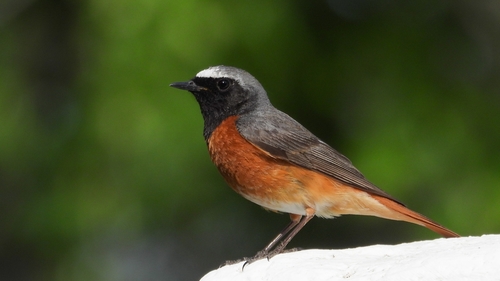
Common Redstart
The Common Redstart (*Phoenicurus phoenicurus*) is a small, vibrant passerine bird known for its striking red tail, which it frequently quivers. It plays a crucial role in controlling insect populations within its woodland and garden habitats. While not holding major cultural significance in many regions, it's a welcomed sign of spring for birdwatchers across Europe and Asia, signifying the return of warmer weather and insect abundance. Its presence indicates a healthy, diverse ecosystem.
13-14.5 cm
Length
20-24 cm
Wingspan
Least Concern
Conservation Status
Distribution
Breeds across Europe and Asia, extending into parts of North Africa. Migrates to sub-Saharan Africa for the winter. Altitudinal range varies, found from sea level to mountainous regions, typically below the tree line.
Lifespan
Typically 2-3 years in the wild, though some individuals can live up to 5 years.
Common Redstart's Habitat
Habitat Types
Open woodlands, Parks, Gardens, Orchards, Hedgerows
Climate Zones
Temperate, Boreal
Adaptations
Prefers areas with mature trees offering suitable nesting cavities. Their agility allows them to thrive in varied terrain, catching insects on the wing or foraging on the ground.
Variations
Two main subspecies are generally recognized: *P. p. phoenicurus* (most of Europe) and *P. p. samamisicus* (southeastern Europe and Asia). *P. p. samamisicus* males have a white wing patch.
Appearance
Breeding Plumage
Males in breeding plumage have a black face and throat, grey upperparts, a white forehead, and a bright orange-red breast and tail. Non-breeding males are duller. Females are generally brown with a pale orange breast and the characteristic red tail.
Seasonal Feather Changes
Males molt into a duller non-breeding plumage after the breeding season. The bright colors return before the next breeding season.
Sex Based Plumage Differences
Significant. Males are much more brightly colored, especially during the breeding season.
Notable Features
Bright red tail, constantly flicked, White forehead patch in breeding males, Black face and throat in breeding males
Diet and Feeding
Primary Foods
Insects, Spiders, Berries, Fruits
Foraging Behavior
Often perches on branches and sallies out to catch flying insects. Also forages on the ground, hopping and picking invertebrates from leaves and soil.
Specializations
Agile flight allows for efficient aerial insect capture. They have a relatively broad bill, suitable for catching a variety of insect types.
Seasonal Diet Variations
Primarily insectivorous during the breeding season. In autumn and winter, diet shifts to include more berries and fruits, especially during migration and on wintering grounds.
Behavior
Social Structure
Generally solitary or in pairs during the breeding season. May form small flocks during migration.
Communication
Variety of calls, including a 'tick' and a 'wheet', Song is a series of short, scratchy phrases, often delivered from a prominent perch, Tail-flicking is a common visual signal, possibly indicating alertness or alarm
Migration
Long-distance migrant. European populations typically fly south across the Mediterranean Sea and Sahara Desert to reach sub-Saharan Africa. Migration is nocturnal.
Territorial or Group Behaviors
Males are territorial during the breeding season, defending their nesting area against rivals. Territories are established through song and displays.
Conservation
Threats
Habitat loss (loss of mature trees and woodlands), Pesticide use (reducing insect prey), Climate change (affecting migration timing and food availability), Collisions with buildings during migration
Protection Programs
General wildlife protection laws in many European countries, Habitat restoration and management initiatives, Provision of nest boxes
Local National Laws
Protected under various national and international wildlife legislation, such as the EU Birds Directive.
Population Trend
Stable
Population Estimates
Estimated global population of 40,000,000-66,000,000 mature individuals.
Interesting Facts
The name 'Redstart' comes from the Old English words 'rēad' (red) and 'steort' (tail).
This accurately describes the bird's most distinctive feature.
They are known to return to the same nesting sites year after year.
This site fidelity highlights the importance of protecting known breeding locations.
Common Redstarts are 'hole-nesters,' meaning they rely on pre-existing cavities.
This makes them vulnerable to the loss of old trees and suitable nesting structures.
Faqs about Common Redstart
What should I do if I find a baby Redstart on the ground?
If the bird is uninjured and appears healthy, it's likely a fledgling that has recently left the nest. It's best to leave it alone, as the parents are likely nearby and still caring for it. If it's in immediate danger (e.g., from a cat), you can gently move it to a safer location nearby, preferably off the ground. Consult a wildlife rehabilitator if the bird appears injured or sick.
How can I attract Redstarts to my garden?
Provide suitable nesting sites (e.g., nest boxes), plant native trees and shrubs that attract insects, and avoid using pesticides. A bird bath can also provide a source of water.
Are Redstarts aggressive?
Males can be territorial during the breeding season, defending their nesting area against other Redstarts. However, they are not generally aggressive towards humans.
Copyright @ Nature Style Limited. All Rights Reserved.
 English
English